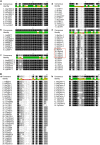New insights into plant glycoside hydrolase family 32 in Agave species
- PMID: 26300895
- PMCID: PMC4524927
- DOI: 10.3389/fpls.2015.00594
New insights into plant glycoside hydrolase family 32 in Agave species
Abstract
In order to optimize the use of agaves for commercial applications, an understanding of fructan metabolism in these species at the molecular and genetic level is essential. Based on transcriptome data, this report describes the identification and molecular characterization of cDNAs and deduced amino acid sequences for genes encoding fructosyltransferases, invertases and fructan exohydrolases (FEH) (enzymes belonging to plant glycoside hydrolase family 32) from four different agave species (A. tequilana, A. deserti, A. victoriae-reginae, and A. striata). Conserved amino acid sequences and a hypervariable domain allowed classification of distinct isoforms for each enzyme type. Notably however neither 1-FFT nor 6-SFT encoding cDNAs were identified. In silico analysis revealed that distinct isoforms for certain enzymes found in a single species, showed different levels and tissue specific patterns of expression whereas in other cases expression patterns were conserved both within the species and between different species. Relatively high levels of in silico expression for specific isoforms of both invertases and fructosyltransferases were observed in floral tissues in comparison to vegetative tissues such as leaves and stems and this pattern was confirmed by Quantitative Real Time PCR using RNA obtained from floral and leaf tissue of A. tequilana. Thin layer chromatography confirmed the presence of fructans with degree of polymerization (DP) greater than DP three in both immature buds and fully opened flowers also obtained from A. tequilana.
Keywords: agave; amino acid motifs; floral tissue; fructans; in silico expression; plant glycoside hydrolase family 32; transcriptome analysis.
Figures






References
LinkOut - more resources
Full Text Sources
Other Literature Sources

